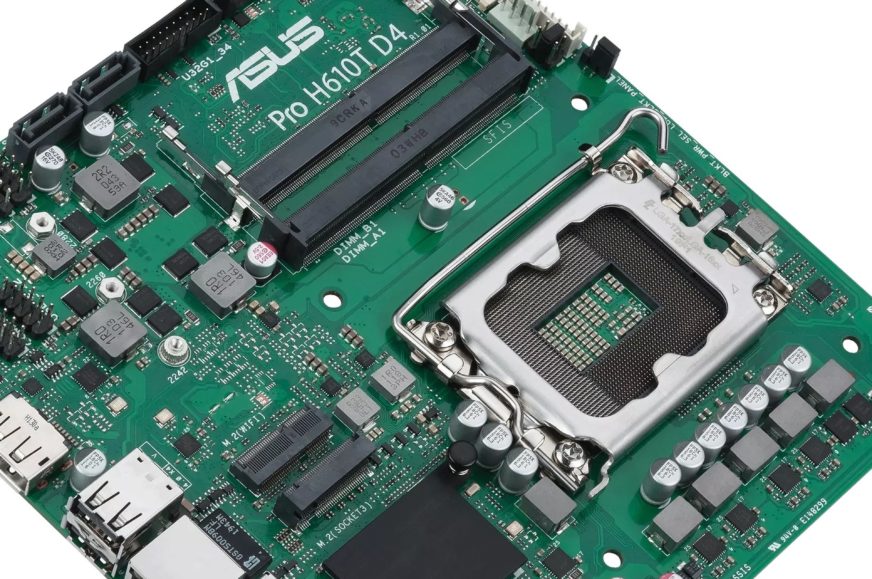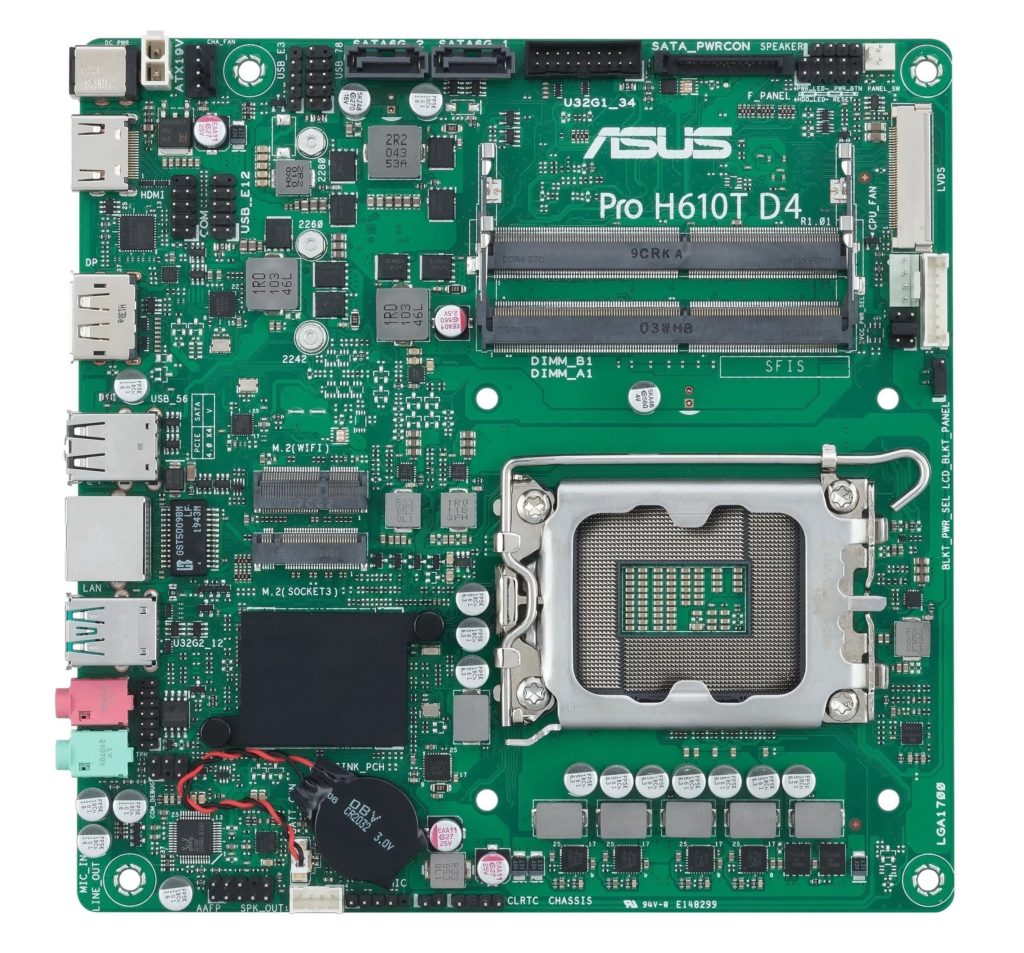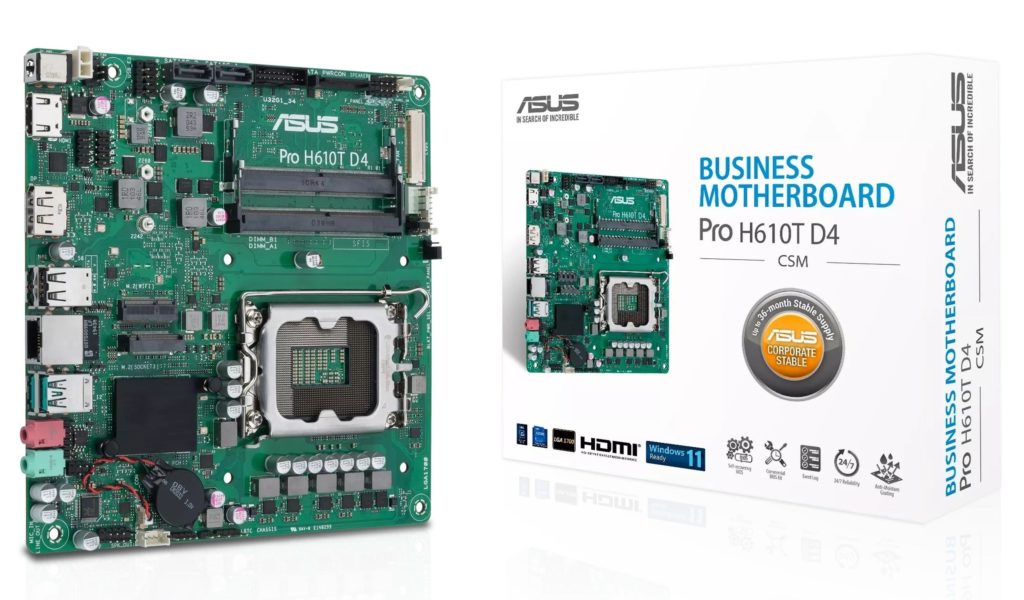Asus Pro H610T D4-CSM
Asus has the first standardized motherboard (Thin Mini-ITX format) with LGA 1700, which is powered by a 19V adapter and is also designed for retail sales. The wait was, naturally, for the power-efficient Intel processors from the 12th Generation Core. The Pro H610T D4-CSM motherboard is designed primarily for enterprise clientele, and its equipment is optimized with this in mind. All Alder Lake processor models with TDP up to 65 W are supported.
The January launch of Intel’s 35-65-watt Alder Lake-S processors was a good impulse for motherboard manufacturers to start looking at motherboards that will find a good use beyond the interest of ordinary consumers, in the enterprise segment. Asus used the Mini-ITX format (170×170 mm) to do this. The Pro H610T D4-CSM is the first motherboard of its kind (combination of dimensions and LGA 1700 support) for Alder Lake and later Raptor Lake processors.
The CSM (Corporate Stable Model) designation refers to Asus’ program that offers 36-month support, which is important in vertical markets. It also gives customers six months’ notice of the end-of-life of a computer system.
The H610T D4-CSM motherboard is thus aimed mainly at the enterprise environment. It can be attractive for various integrated systems for which the low performance of mobile BGA processors (often used in minimalist barebone PCs) is not enough. Among the “special” equipment of the board are internal connectors for connection and control of thin panels, LVDS connector, DMIC and internally there is also a COM serial interface.
There are fewer storage connectors, two SATA-type connectors for inch SSDs/HDDs and one M.2 slot for PCIe 3.0 SSDs – a full-size (four-lane connected) and a hybrid (with SATA III support). There’s one more M.2 slot, but it’s with a E-key, for a WiFi module.
There are four external USB ports on the rear panel, two of which are 2.0 standard (for connecting peripherals with low data bandwidth, i.e., mouse, keyboard, printer, …) and two fast, 3.2 gen. 2 standard (10 Gb/s). In addition to the two video outputs (DP 1.4a and HDMI 2.1), there is only an RJ-45 connector for gigabit Ethernet and a pair of 3.5 mm jacks (stereo output and microphone input) on the rear panel. For multimedia use, it’s not very suitable due to the very simple audio part. For signaling purposes in the target environment, this audio is sufficient.
The Asus H610T D4-CSM is built on the Intel H610 chipset and the 5-phase Vcore power delivery is just right for processors with TDPs up to 65 W. Whether the power supply will strictly adhere to the recommended values for PL1 (TDP/65 W) we don’t know, but the board probably won’t work with more powerful processors with a TDP of 125 W, and you won’t even get into the BIOS with them, where there would be an option to manually reduce the power draw. However, this assumption will be confirmed only by the list of supported processors, which is missing on asus.com for now. Later, however, you might find it in this link.
The memory supported is DDR4 in SO-DIMM format (modules can be installed in a count of two, dual-channel). The official speed support is up to 3200 MHz and capacity up to 64 GB.
The H610T D4-CSM board is already in stock in some stores at an end price of around 145 EUR.
English translation and edit by Jozef Dudáš
- Contents
- Asus Pro H610T D4-CSM















19 volt 2 pin Molex is wire backward with the positive pin on the non-lock pin side of Molex. This is an Asus QC error or a manufacturing error from Asus’s board supplier, as I do not belive this board is made in house at Asus.
Good point. After the long screws on the RX 5700 (XT), the unfinished coating on some Strix XF120 fan blades, and I don’t know what else, this will just be another one of Asus’ QC inconsistencies. We might be surprised how it works out there. The service centre in the Czech Republic (in Ostrava) seems to be a pretty decent one though – we did a visit there two years ago.